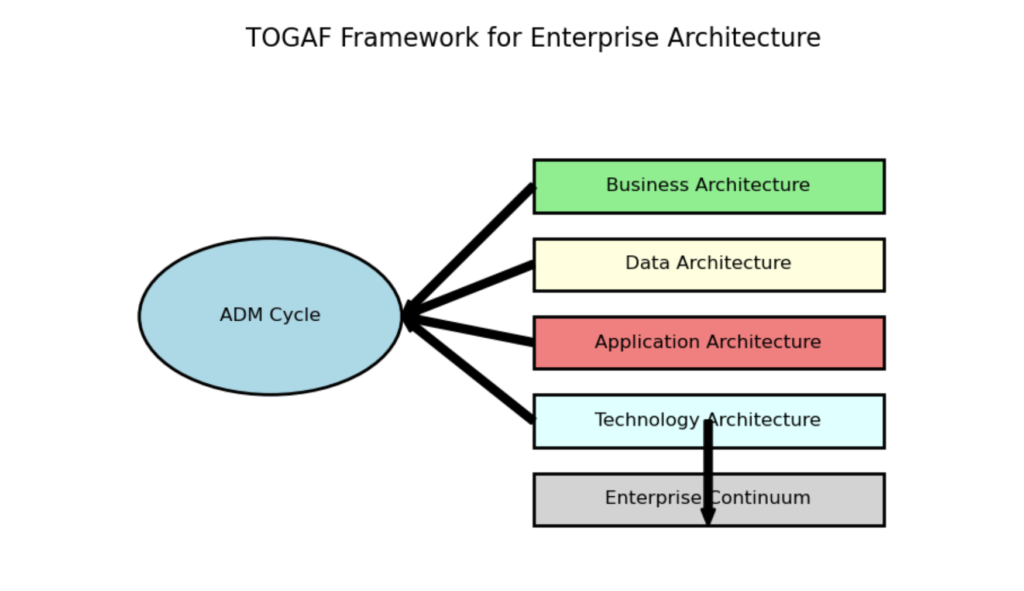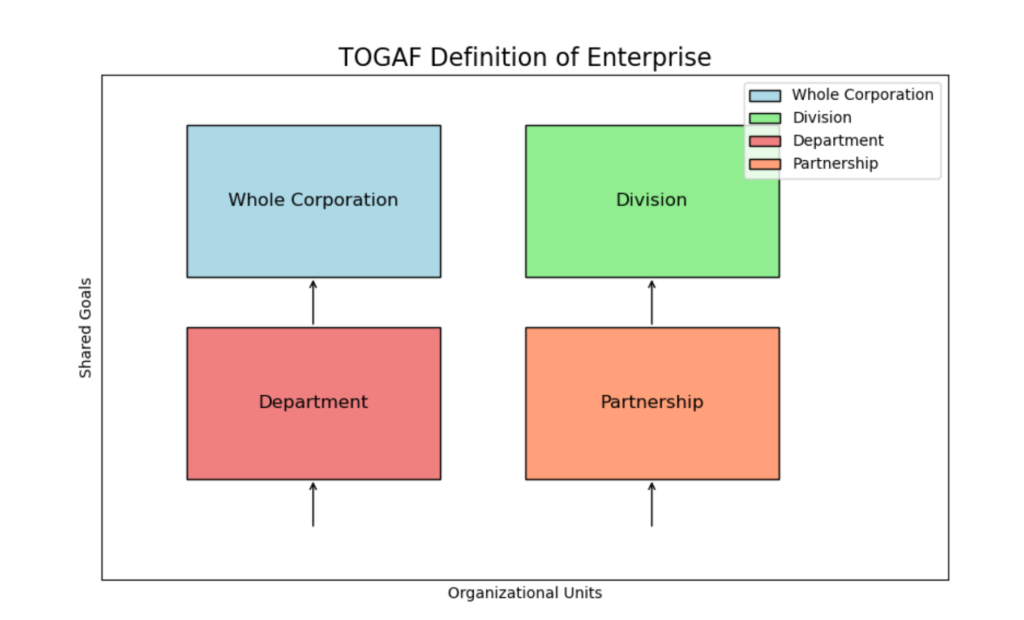-
TOGAF (The Open Group Architecture Framework) organizes enterprise architecture into four interrelated domains. These domains provide a structured way to analyze, design, and implement systems that align with business goals.
🔍 The Four Architecture Domains (Explained in Detail)
1. Business Architecture
This domain defines:
- The organizational structure
- Business processes
- Capabilities, functions, and roles
- Strategic goals and objectives
It answers:
👉 What does the business do? Who does it? Why does it matter?2. Data Architecture
This domain focuses on:
- Data models (conceptual, logical, physical)
- Data flows and data governance
- Data storage, integration, and security
It answers:
👉 What data is needed? Where is it stored? How is it accessed and secured?3. Application Architecture
This domain defines:
- The software applications used in the enterprise
- Interactions between applications
- Interfaces and integration patterns
It answers:
👉 What applications support the business? How do they interact?4. Technology Architecture
This domain includes:
- Infrastructure (servers, networks, cloud platforms)
- Middleware, operating systems, and technical standards
- Security, performance, and scalability
It answers:
👉 What technology supports the applications and data?
🧠 Real-World Example: Smart City Transportation System
Let’s say a city government is building a Smart Transportation System to reduce traffic congestion and improve commuter experience.
🔹 Business Architecture
- Goal: Reduce average commute time by 20% in 2 years.
- Stakeholders: City planners, commuters, traffic police, public transport authorities.
- Processes: Route planning, traffic monitoring, public transport scheduling.
🔹 Data Architecture
- Data Sources: GPS data from buses, traffic sensors, commuter feedback, weather data.
- Data Models: Real-time traffic flow, historical congestion patterns.
- Governance: Data privacy policies, open data standards for public access.
🔹 Application Architecture
- Apps: Mobile app for commuters, dashboard for traffic control center, APIs for third-party developers.
- Integration: Real-time data feeds from IoT sensors, integration with Google Maps and public transport APIs.
🔹 Technology Architecture
- Infrastructure: Cloud-based platform (e.g., AWS or Azure), 5G connectivity, edge computing for real-time processing.
- Security: End-to-end encryption, role-based access control.
- Scalability: Designed to support millions of data points per day.
🖼 Visual Diagram
Here’s a visual representation of how these domains stack and interact:

📝 Summary
The four architecture domains in TOGAF—Business, Data, Application, and Technology—offer a comprehensive framework for aligning IT with business strategy. Whether you’re building a smart city, modernizing a bank, or transforming healthcare, these domains help ensure that every layer of your enterprise is working in harmony.
-
A Framework for Enterprise Architecture
- Posted on: June 2, 2025
- by: Anand Pandey
- 0 Comments
In a world where technology and business are deeply intertwined, organizations need a structured approach to align their IT capabilities with strategic goals. That’s where TOGAF (The Open Group Architecture Framework) comes in—a comprehensive framework for designing, planning, implementing, and governing enterprise architecture.
🧱 What is TOGAF?
TOGAF is a globally recognized framework that provides a methodology and set of tools for developing enterprise architecture. It helps organizations manage complexity, improve decision-making, and ensure that IT investments support business outcomes.
At its core, TOGAF is built around the Architecture Development Method (ADM)—a step-by-step approach to developing and managing enterprise architecture.
🧩 Key Components of the TOGAF Framework
1. Architecture Development Method (ADM)
The ADM is the heart of TOGAF. It provides a structured cycle for developing architecture, from vision to implementation and governance.
2. Architecture Domains
TOGAF divides enterprise architecture into four domains:
- Business Architecture – Defines business strategy, governance, and processes.
- Data Architecture – Structures data assets and data management.
- Application Architecture – Describes individual applications and their interactions.
- Technology Architecture – Details the infrastructure and technology stack.
3. Enterprise Continuum
This is a classification model that helps organize and reuse architectural assets across the enterprise—from generic foundation architectures to specific organizational solutions.
🖼 Visualizing the TOGAF Framework
Here’s a visual diagram that illustrates how the ADM cycle connects with the architecture domains and the Enterprise Continuum:

✅ Real-World Example
Imagine a national education board planning a digital transformation:
- The ADM cycle guides the process from defining the vision to deploying new systems.
- The Business Architecture defines goals like improving student access and digital learning.
- The Data Architecture structures student records, performance metrics, and learning content.
- The Application Architecture includes learning management systems and mobile apps.
- The Technology Architecture covers cloud infrastructure, security, and device management.
- The Enterprise Continuum helps reuse proven models and adapt them to the education sector.
📝 Summary
The TOGAF framework offers a powerful, structured approach to enterprise architecture. By combining the ADM cycle, architecture domains, and the Enterprise Continuum, TOGAF helps organizations align technology with strategy, reduce complexity, and drive innovation. Whether you’re modernizing legacy systems or launching new digital initiatives, TOGAF provides the blueprint for success.
-
The Purpose of Enterprise Architecture
- Posted on: June 2, 2025
- by: Anand Pandey
- 0 Comments
In enterprise architecture, clarity of scope is essential. TOGAF (The Open Group Architecture Framework) offers a flexible and inclusive definition of “enterprise” that helps architects align technology with business goals effectively.
🔍 What Does TOGAF Mean by “Enterprise”?
TOGAF defines an enterprise as:
“Any collection of organizations that has a common set of goals.”
This means an enterprise isn’t limited to a single company. It could be:
- A corporation
- A business unit or department
- A government agency
- A partnership between multiple organizations
The key is the shared purpose—not the organizational boundaries.
🎯 Why Define the Enterprise?
The purpose of defining the enterprise in TOGAF is to:
- Establish a clear architectural scope
- Align IT systems with strategic business objectives
- Identify relevant stakeholders and their concerns
- Ensure consistency across systems, processes, and governance
By clearly defining the enterprise, architects can focus on delivering value where it matters most.
✅ Real-World Example
Imagine you’re working on a digital platform for a public-private healthcare initiative. The platform involves:
- A government health department
- A private hospital network
- A third-party logistics provider for medical supplies
Even though these are separate organizations, they share a common goal: improving healthcare delivery. In TOGAF terms, they collectively form an enterprise for the purpose of this architecture.
🧩 Visualizing the TOGAF Enterprise Scope
Here’s a diagram that illustrates how different organizational units can be part of a single enterprise when they share common goals:

📝 Summary
Understanding the purpose of defining an enterprise in TOGAF is foundational to successful architecture work. It ensures that all efforts are aligned with shared goals, regardless of organizational boundaries. Whether you’re working within a single department or across multiple entities, TOGAF’s flexible definition helps you focus on delivering strategic value through architecture.
-
In TOGAF (The Open Group Architecture Framework), the term “Enterprise” has a specific and flexible meaning that goes beyond just a single company or organization.
🔍 TOGAF Definition of “Enterprise”
According to TOGAF:
“An enterprise is any collection of organizations that has a common set of goals.”
This could be:
- A whole corporation
- A division within a corporation
- A government agency
- A partnership of multiple organizations
- Even a department or a project team, depending on the context
The key idea is that the enterprise is defined by shared goals and objectives, not necessarily by legal or organizational boundaries.
🧠 Why This Matters in Architecture
In enterprise architecture, defining the scope of the enterprise is crucial because it determines:
- What systems and processes are included
- Who the stakeholders are
- What goals the architecture must support
✅ Example
Let’s say you work at Dell Technologies.
- If you’re designing architecture for Dell’s global e-commerce platform, your “enterprise” might be the entire Dell Digital division.
- If you’re focused only on the Cart & Checkout team, your enterprise might be just that specific product team.
- If Dell partners with a logistics company to streamline delivery, and you’re designing a shared system, the “enterprise” could include both organizations.
Here’s a visual diagram that illustrates the TOGAF concept of an Enterprise:

🔍 Diagram Explanation:
- Whole Corporation: The broadest scope, representing the entire organization.
- Division: A major business unit within the corporation.
- Department: A smaller, focused team or function within a division.
- Partnership: A collaboration between different organizations.
All of these are considered part of an “enterprise” in TOGAF as long as they share common goals.
🧩 Summary
Term Meaning in TOGAF Context Enterprise A group with shared goals (not just a company) Scope Defined by purpose, not legal structure Example A department, a business unit, or a multi-org partnership
Tag